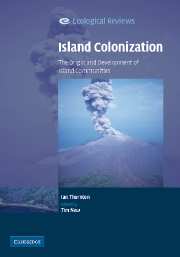Book contents
- Frontmatter
- Contents
- Editorial preface
- Acknowledgements
- PART I Theoretical and experimental studies
- 1 Introduction
- 2 Theoretical and experimental colonization
- PART II Natural recolonization after devastation
- PART III The recolonization of devastated islands
- PART IV Assembly of biotas on new islands
- PART V Colonization and assembly
- References
- Index
2 - Theoretical and experimental colonization
Published online by Cambridge University Press: 12 January 2010
- Frontmatter
- Contents
- Editorial preface
- Acknowledgements
- PART I Theoretical and experimental studies
- 1 Introduction
- 2 Theoretical and experimental colonization
- PART II Natural recolonization after devastation
- PART III The recolonization of devastated islands
- PART IV Assembly of biotas on new islands
- PART V Colonization and assembly
- References
- Index
Summary
Theoretical models
The colonization of islands can be studied in theory by constructing models on the computer. Such models require that certain assumptions be built into the model, and, although these are necessarily simplified (and always fail to take into account all the parameters relevant to natural situations), insights can be gained from their use. As an example, one of the questions that can be investigated in this way is the relative roles of chance (stochasticity) and determinism in the colonization process. This question has been debated vigorously by island biogeographers, and an understanding of the different points of view is important in introducing the topics.
Chance and determinism
In the process of assembly of a functioning community from a number of species of living things, both stochastic and deterministic elements are almost always involved. Several biologists have attempted to assess the interplay of these two elements of the process. After using a very simplified model, Seamus Ward and I concluded that, on theoretical grounds, in the early stages of colonization stochasticity (in the sense of the likelihood that in a population of similar islands the communities that are assembled will be different from one another) will be low. Pioneer colonizers are invariably species with good dispersal powers and/or establishment characteristics. Their arrival rates will be high and very similar to one another, and the intervals between colonizing events (colonizing intervals) will be short.
- Type
- Chapter
- Information
- Island ColonizationThe Origin and Development of Island Communities, pp. 10 - 26Publisher: Cambridge University PressPrint publication year: 2007



